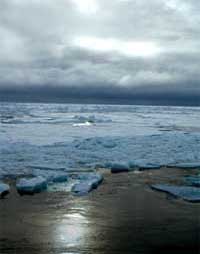CO2 and Temperature Change
 What causes the Earth’s climate to change?
What causes the Earth’s climate to change?
The level of carbon dioxide in the atmosphere is closely related to global temperature.
Carbon Dioxide Concentration
Carbon dioxide (CO2) is a "greenhouse gas." It absorbs energy from the Sun and then releases it back into the atmosphere. This "greenhouse effect" keeps the Earth warmer than it would be if this process did not occur.
Throughout most of the past 425,000 years the concentration of CO2 has ranged between 180 and 280 parts per million (ppm). When the concentration was at its highest the world was warmer. The Antarctic ice cores that provided evidence of ancient temperatures also contain tiny air bubbles that were trapped as snow accumulated. These bubbles have been analyzed and provide a record of CO2 concentration over time. There is a close correspondence between average global temperature and CO2 concentration.
Are the changes in CO2 concentration causing changes in temperature or is it the other way around? It’s both.
Greenhouse effectCarbon dioxide (CO2) absorbs energy radiated by the Earth and then releases it back into the atmosphere. |
A major reason for the drop in atmospheric CO2 as temperatures decrease is that colder oceans are able to dissolve more CO2. There is a constant exchange of CO2 between the atmosphere and the oceans. Gas is dissolved and also released into the atmosphere. The balance is determined largely by temperature. You can see this effect for yourself. Open a bottle of carbonated water or soda. Pour some into each of two glasses. Put one in the refrigerator and leave one at room temperature. Come back in about an hour and take a drink from each. The one in the refrigerator has retained more bubbles. The fluctuations in CO2 level in the atmosphere are part of the carbon cycle, a complex process by which carbon moves between the atmosphere, biological organisms, the Earth’s crust, and the oceans.
The drops in CO2 concentration do not always begin until after a cooling period has begun. Then, as an ice age is ending, the concentrations may remain low for some time into the warming period. This means that the CO2 changes cannot be the driving force in initiating these major climate shifts. But as the climate cools, the concentration of CO2 drops and this has a further cooling effect. And as the climate is warming, more CO2 is released into the atmosphere, further increasing global temperatures. This is called a positive feedback loop.
|
Image based on data from NOAA. Over the past 425,000 years, cool periods have coincided with times when the CO2 concentration in the atmosphere was lower. When there is less CO2 in the atmosphere, the greenhouse effect is reduced and the world cools. The blue and red line indicates the variation in average global temperature compared with the 1961–1990 average. The green line shows the concentration of CO2 in the atmosphere. (Pay close attention to the right-hand edge of the graph.) This graph shows four eras when the world was cooler than it is today. These are separated by brief warm periods, like the one we are now in. |
Another positive feedback loop appears to be occurring now in the Arctic. During the summer the ice floating in the Arctic Ocean partly melts. Each winter the ice cover increases. In recent years the ice has been retreating more in the summer and recovering less in the winter. The process tends to reinforce itself. Here’s how: Ice reflects quite a bit of sunlight. Water is much less reflective and absorbs more of the Sun’s energy. As the amount of open water increases, more of the Sun’s energy is absorbed. The water temperature increases. This causes more melting, which results in more open water, which…
Further Explanations for Climate Change
There is a clear relationship between atmospheric CO2 concentrations and global temperature. But this does not tell us what initiates the large climatic changes we have seen. The explanation may have to do with the motion of the Earth and the Sun.
This content has been re-published with permission from SEED. Copyright © 2024 Schlumberger Excellence in Education Development (SEED), Inc.



.jpg)